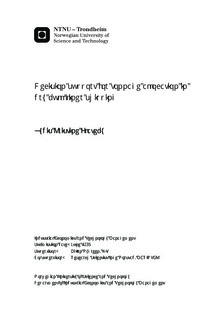| dc.contributor.advisor | Nygreen, Bjørn | nb_NO |
| dc.contributor.advisor | Norstad, Research Scientist Inge | nb_NO |
| dc.contributor.author | Flateby, Oydis Kristine | nb_NO |
| dc.date.accessioned | 2014-12-19T14:29:23Z | |
| dc.date.available | 2014-12-19T14:29:23Z | |
| dc.date.created | 2014-06-10 | nb_NO |
| dc.date.issued | 2013 | nb_NO |
| dc.identifier | 723434 | nb_NO |
| dc.identifier | ntnudaim:9404 | nb_NO |
| dc.identifier.uri | http://hdl.handle.net/11250/266536 | |
| dc.description.abstract | Maritime transportation represents the major transportation mode of international trade and the world seaborne trade continues to grow. There exists however an oversupply of ships representing a serious challenge for ship owners as the freight rates are at unprofitable levels. It is therefore important to have an optimal utilization of the fleet. This thesis studies the tonnage allocation problem for a liner shipping company with the purpose to illustrate how optimisation based methods can be used as decision support when planning fleet deployment in liner shipping. In the context of data from a real shipping company is an optimisation model developed. A special emphasis has been on the implementation and preprocessing in order to obtain an efficient model. The model has then been the basis for a performance study and a thorough analysis of the effects when adjusting input parameters and constraints. The company has two types of trades which they can sail; mandatory trades and optional trades. In addition all ships have to attend service once every third year. If the company is not able to sail voyages of mandatory trades themselves, they can hire spot ships. Every voyage of a trade has a time window for when the voyage can start, and there is also a requirement of fairly evenly spread voyages of the same trade. The strictness of the spread of voyages is regulated by a factor. Aspects which have been analysed in this thesis are the timing of trades with regard to spread of voyages and time windows, cost of spot ships, service trades, origin port and earliest available time for each ship and the introduction of optional trades. An alternative, shorter way of sailing a voyage has also been introduced to the model in order to try to obtain a better utilization of the fleet.The results show the value of flexibility, but also the impact it has on the computational time. Limitations should be added to the problem with careful consideration in order to not exclude possible solutions. The results also show how obligations done in one period put constraints on what a shipping company can do in the next period since the fleet is tied up. | nb_NO |
| dc.language | eng | nb_NO |
| dc.publisher | Institutt for industriell økonomi og teknologiledelse | nb_NO |
| dc.title | Decision support for tonnage allocation in dry bulk liner shipping | nb_NO |
| dc.type | Master thesis | nb_NO |
| dc.source.pagenumber | 154 | nb_NO |
| dc.contributor.department | Norges teknisk-naturvitenskapelige universitet, Fakultet for samfunnsvitenskap og teknologiledelse, Institutt for industriell økonomi og teknologiledelse | nb_NO |

